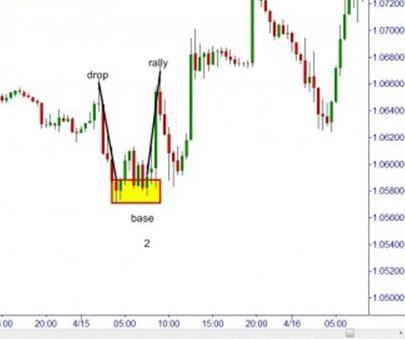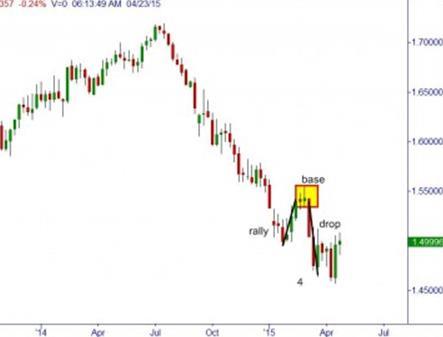![]()
Hello traders! If you are a long time reader of our Lessons from the Pros newsletters you should know by now that we believe you should sell in supply and buy in demand. All of our instructors talk about that! If you are a long term reader of my own newsletters, you should know that I like to use easy analogies to demonstrate some of the different aspects of trading. This week is no different.
As the title of this week’s newsletter suggests, we will discuss two of the four patterns in the Forex market, the other two are beyond the scope of this article. However, these four patterns relate to stocks, futures, Forex and pretty much anything that can be charted! I know what some of you might be thinking, “Rick, I’ve read several dozen books about trading and they talk about dozens of different patterns, from head and shoulders, to double tops and bottoms, to cup and handle to the bartender’s mustache and that is way more than four total!” Actually, all of those patterns are BUILT from the four patterns we teach at Online Trading Academy.
As you probably know by now, the market can only go in three directions: up, down and sideways. Basic stuff, right? Those three directions actually build our four patterns. We call up moves rallies, down moves drops and sideways moves bases. So the terms up, down and sideways are renamed as rally, drop and base. So far so good? Now, two of the four patterns are rally, base, drop; and drop, base, rally. One of the great things about trading is what we call the “fractal” nature of the markets. This means that the charts (normally!) react the same way no matter what time frame chart you are looking at, meaning you trade a rally-base-drop on a five minute chart the same way you would trade a rally-base-drop on a daily chart. The only difference between the two traders who might use these two charts is the frequency of trades that the smaller time frame trader will see vs. the longer time frame trader. Let’s look at the two patterns on a chart.
In the above chart, above the number “2,” I’ve labeled a slightly complex drop-base-rally. Price fell for a few candles, had a slightly volatile base of sideways action for several candles, then an explosive move to the upside for a few candles.
In this GBPUSD weekly chart, above the number “4,” I’ve labeled an easy rally-base-drop where the market moved up for a few candles, sideways for a couple, followed by a sharp drop.
You now have two of the four of the patterns that exist in trading. Any of your more complex patterns that you’ve read about consist of a series of these patterns. I intentionally chose not to label any of the “classic” technical analysis patterns. One of the more interesting things I’ve noticed from my nine years of teaching traders is the desire by people to make what should be simple into something very complex. You should see some of the complicated charts I’ve been shown! Now, I mean no disrespect to the traders out there who use multiple Fibonacci-butterfly-overbought/sold-crossing-confluence indicators to trade, provided they are making money. If you are using all of that stuff and NOT making money, perhaps you should simplify your charts! It doesn’t get much simpler than these four basic patterns.
Earlier in this newsletter I mentioned the fact that I like to use simple (often driving) analogies to demonstrate my point. When you look at the two charts above, how many of these patterns do you actually see? Once you train your eyes to look for the simple stuff these patterns should jump out at you! What are the REAL differences between one rally-base-drop and another rally-base-drop? The only differences that exist between two similar patterns are the SPEED of the rallies, the DISTANCE of the rallies, the TIME of the base and the VOLATILITY (width) of the base.
How is this similar to driving? Imagine you are driving to an old job that you had where you worked normal business hours, Monday-Friday 8am to 5pm, which sounds like prison to me. Now imagine that you drove to this prison of a job at 7:30am on Monday morning, stuck in traffic with everyone else. I want you to think about the actual movement of the car as a rally (or drop) and every time you stop at a traffic light as a base. With a lot of traffic your “rallies” are very slow and your “bases” take numerous candles (or time.) Now imagine this same commute to work but instead of Monday, consider taking that drive at 7am on a Sunday morning. What is the difference? Obviously, the amount of traffic, right? With little traffic your “rallies” will be much faster and farther and your “bases” will take little time. Which type of traffic would you prefer to drive in? So, which market would you prefer to trade in?
There you have it, two of the key patterns of the market, plus my obligatory driving analogy. As you train your eyes to look for these patterns, simplifying your trading, I would expect you to take fewer, better trades, which is always my goal!
This content is intended to provide educational information only. This information should not be construed as individual or customized legal, tax, financial or investment services. As each individual's situation is unique, a qualified professional should be consulted before making legal, tax, financial and investment decisions. The educational information provided in this article does not comprise any course or a part of any course that may be used as an educational credit for any certification purpose and will not prepare any User to be accredited for any licenses in any industry and will not prepare any User to get a job. Reproduced by permission from OTAcademy.com click here for Terms of Use: https://www.otacademy.com/about/terms
Editors’ Picks

EUR/USD flatlines below 1.1800 amid trading lull, awaits Fed Minutes
EUR/USD trades around a flatline below 1.1800 in European trading on Tuesday. The pair lacks any trading impetus as the US Dollar moves little amid market caution ahead of the Fed's December Meeting Minutes release, which could offer insights into the Federal Reserve’s 2026 outlook.

GBP/USD retakes 1.3500 despite the year-end grind
GBP/USD finds fresh demand and retakes 1.3500 on Tuesday as markets grind through the last trading week of the year. Despite the latest uptick, the pair is unlikely to see further progress due to the year-end holiday volumes.

Gold holds the bounce on Fed rate cut bets, safe-haven flows
Gold holds the rebound near $4,350 in the European trading hours on Tuesday. The precious metal recovers some lost ground after falling 4.5% in the previous session, which was Gold's largest single-day loss since October. Increased margin requirements on gold and silver futures by the Chicago Mercantile Exchange Group, one of the world’s largest trading floors for commodities, prompted widespread profit-taking and portfolio rebalancing.

Tron steadies as Justin Sun invests $18 million in Tron Inc.
Tron (TRX) trades above $0.2800 at press time on Monday, hovering below the 50-day Exponential Moving Average (EMA) at $0.2859.

Bitcoin Price Annual Forecast: BTC holds long-term bullish structure heading into 2026
Bitcoin (BTC) is wrapping up 2025 as one of its most eventful years, defined by unprecedented institutional participation, major regulatory developments, and extreme price volatility.
RECOMMENDED LESSONS
Making money in forex is easy if you know how the bankers trade!
I’m often mystified in my educational forex articles why so many traders struggle to make consistent money out of forex trading. The answer has more to do with what they don’t know than what they do know. After working in investment banks for 20 years many of which were as a Chief trader its second knowledge how to extract cash out of the market.
5 Forex News Events You Need To Know
In the fast moving world of currency markets where huge moves can seemingly come from nowhere, it is extremely important for new traders to learn about the various economic indicators and forex news events and releases that shape the markets. Indeed, quickly getting a handle on which data to look out for, what it means, and how to trade it can see new traders quickly become far more profitable and sets up the road to long term success.
Top 10 Chart Patterns Every Trader Should Know
Chart patterns are one of the most effective trading tools for a trader. They are pure price-action, and form on the basis of underlying buying and selling pressure. Chart patterns have a proven track-record, and traders use them to identify continuation or reversal signals, to open positions and identify price targets.
7 Ways to Avoid Forex Scams
The forex industry is recently seeing more and more scams. Here are 7 ways to avoid losing your money in such scams: Forex scams are becoming frequent. Michael Greenberg reports on luxurious expenses, including a submarine bought from the money taken from forex traders. Here’s another report of a forex fraud. So, how can we avoid falling in such forex scams?
What Are the 10 Fatal Mistakes Traders Make
Trading is exciting. Trading is hard. Trading is extremely hard. Some say that it takes more than 10,000 hours to master. Others believe that trading is the way to quick riches. They might be both wrong. What is important to know that no matter how experienced you are, mistakes will be part of the trading process.
The challenge: Timing the market and trader psychology
Successful trading often comes down to timing – entering and exiting trades at the right moments. Yet timing the market is notoriously difficult, largely because human psychology can derail even the best plans. Two powerful emotions in particular – fear and greed – tend to drive trading decisions off course.


